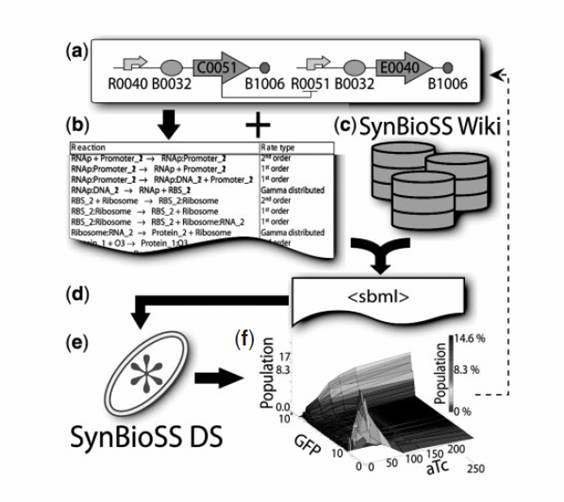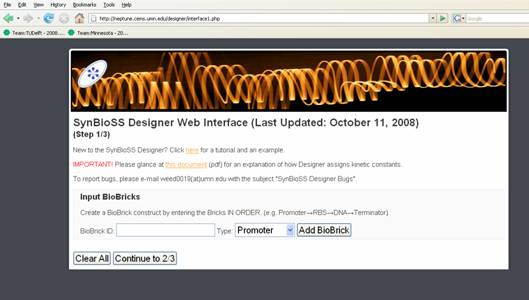Team:Minnesota/Designer
From 2009.igem.org
| Home | The Team | The Project | Submitted Parts | Modeling | SynBioSS Designer | Parts Characterization | Experiments and Calendar |
|---|
SynBioSS
|
The entire software suite can be found via the SynBioSS [http://synbioss.sourceforge.net home page]. The software suite is open source that runs on Windows, Macintosh and Linux. It does not require command-line programming and thus facilitates the modeling of biochemical reactions.
Introduction
SynBioSS is made of three components: Desktop Simulator, Designer, and Wiki. The graduate students and postdoctoral fellows in the Kaznessis lab have been developing the algorithms for stochastic simulations of gene regulatory networks. They have packaged those with a user-friendly GUI in SynBioSS Desktop Simulator.
Designer and Wiki are developed entirely by iGEM team undergraduate students (really, the graduate students don't know Python, PHP, or Javascript). Last year we developed the first version of these tools, which were stand-alone. This year we are developing and documenting SynBioSS Designer and SynBioSS wiki as new technical standards that support the design of BioBrick Parts or Devices, the construction of BioBrick Parts or Devices, the characterization of BioBrick Parts or Devices, and the analysis, modeling, and simulation of BioBrick Parts or Devices. This is occurring thanks to the connection with the BioBrick database. We are writing all kinds of scripts to fetch useful BioBrick information from the database to any user's desktop.
Imagine having a software tool that can build and simulate gene regulatory networks for you with minimal input. Just enter the IDs of the BioBricks in your system and SynBioSS will generate an SBML or NetCDF file of all the molecular biology dogma interactions: transcription, translation, regulation, degradation, and induction. Use Wiki to populate the kinetic constants and take this file to conduct sophisticated simulations of the dynamics of your synthetic construct.
Voila! From Biobrick IDs to distributions of protein molecules in a cell population.
All of our codes are made publicly available with Open Licenses.
SynBioSS Designer
SynBioSS Designer is an application for the automatic generation of sets of biomolecular reactions. This software allows a user to input the molecular parts involved in gene expression and regulation (e.g. promoters, transcription factors, ribosomes, etc.) The software then generates complete networks of reactions that represent transcription, translation, regulation, induction and degradation of those parts. To facilitate the creation of detailed kinetic models of synthetic gene networks composed of BioBricks, we have adapted SynBioSS Designer to automatically generate a kinetic model from a construct composed entirely of BioBricks. A NetCDF or SBML file is generated for simulations.
Our goal for this year's iGEM competition is to overhaul the user interface for the SynBioSS Designer. After updating the modeling component to account for polycistronic strands of Coding DNA, our primary goal is to integrate a search box that will allow users to query the BioBricks database and retrieve relevant characteristics. Currently, the user must manually input all information about every BioBrick (e.g. for promoters, the user must input whether the promoter is constitutively on or off, whether the promoter has operator sites, where these operator sites are located, etc.). Once completed, users will be able to search the Registry for BioBricks that fit search parameters, pull them into a convenient and user-friendly interface in SynBioSS, and export a NetCDF or SBML file for computation, constructing the entire complex biological system of reactions in a matter of minutes.
SynBioSS Wiki
The inaccessibility of requisite kinetic data complicates the generation of detailed mechanistic models. We address this barrier by creating a web accessible database curated by users in a “Wiki” format. SynBioSS Wiki is a significant extension of the open-source Mediawiki software. The Wiki stores reaction kinetic data in a formatted and searchable scheme with references to the relevant literature. This framework allows for the input of reactions whose rates are described either by elementary first & second order rate equations or any arbitrarily complex rate equation defined using MathML (e.g. Hill type reactions). Reactions may be searched via participating molecules which may be proteins, DNA sequences, small molecules, etc. Once located, reactions of interest (along with their associated kinetic data) may be collected. The completed model may be exported in SBML format for additional editing or simulation.
It is also through the SynBioSS Wiki databases that SynBioSS Designer can access and proliferate kinetic information related to the simulation of BioBricks, thus extending the utility of the database for the benefit of the greater modeling community. To jumpstart the process, we have entered the known biomolecular interactions in the expression and regulation of well-studied operons, such as the lactose, the tetracycline and the arabinose operons.
 "
"


